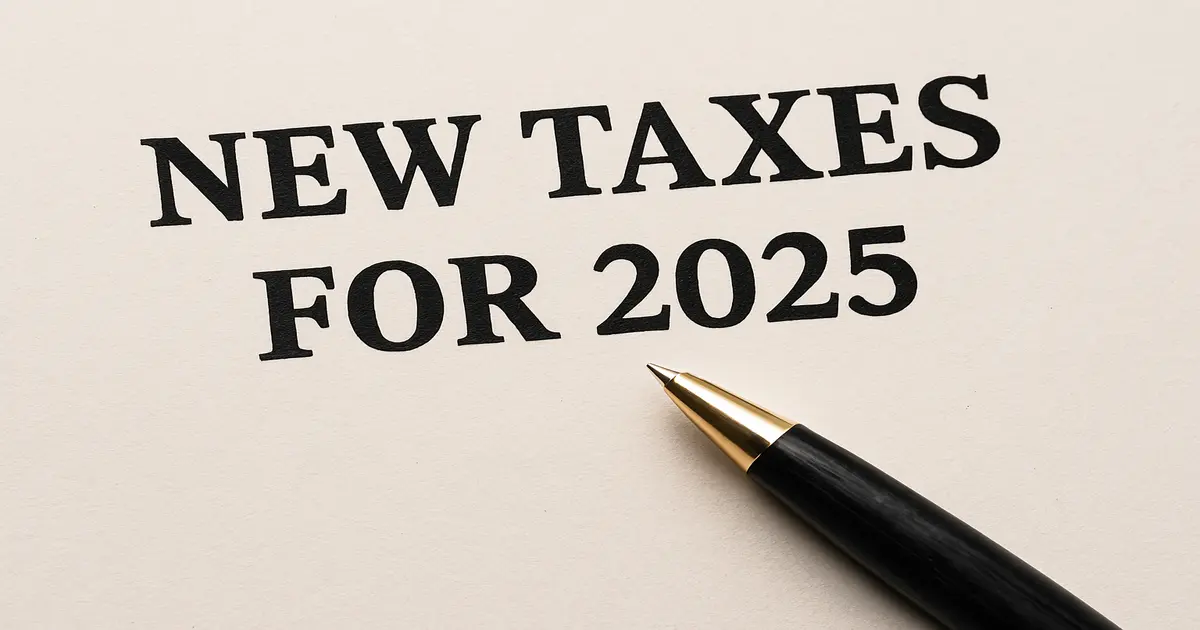12 Major UK Tax Changes in 2025 That Will Impact Your Finances
As the new tax year begins, significant changes to UK tax rules and allowances are set to affect millions of households and businesses.
We outline the 12 most impactful tax changes in 2025, detailing how they affect your income, savings, pensions, and overall financial planning.
1. National Insurance Cuts for Employees and the Self-Employed
The government has implemented a 2p cut in National Insurance Contributions (NICs) for both employed and self-employed workers.
- Employees (Class 1 NICs): Main rate reduced from 10% to 8% on earnings between £12,570 and £50,270.
- Self-employed (Class 4 NICs): Main rate reduced from 9% to 6% on annual profits within the same band.
This change is expected to save:
- £450 per year for employees earning £35,000.
- £350+ for self-employed individuals with similar profit levels.
Additionally, Class 2 NICs have been abolished, simplifying contributions for self-employed workers earning over £12,570.
2. Freezing of Income Tax Thresholds Until 2028
The personal allowance remains at £12,570, and the higher rate threshold stays at £50,270, leading to fiscal drag. More individuals are being pushed into higher tax bands as wages rise.
Implication: As earnings increase, a larger portion of income is taxed at 40%, impacting disposable income and take-home pay.
3. Reduction in Capital Gains Tax on Property Sales
From April 2025:
- Capital Gains Tax (CGT) on residential property is cut from 28% to 24% for higher-rate taxpayers.
- Basic-rate taxpayers remain at 18%.
This aims to stimulate housing market transactions and reduce CGT bills for landlords and second-home sellers.
4. Dividend Tax-Free Allowance Slashed to £500
The annual tax-free dividend allowance has dropped from £1,000 to £500 in 2025.
Tax BandDividend Tax Rate
Basic Rate 8.75%
Higher Rate 33.75%
Additional Rate 39.35%
This significantly impacts small business owners and investors relying on dividend income.
5. Pension Lifetime Allowance Fully Abolished
The Lifetime Allowance (LTA) on pensions has been scrapped, allowing individuals to build unlimited pension pots without punitive tax charges on excess amounts.
However, limits remain on tax-free lump sum withdrawals, capped at 25% of £1,073,100 (i.e., £268,275).
6. Child Benefit Clawback Threshold Increased
The High-Income Child Benefit Charge (HICBC) threshold has increased from £50,000 to £60,000.
- Full withdrawal now occurs at £80,000, up from £60,000.
- Affected families will retain more of their child benefits as a result.
This change helps mitigate the “child benefit trap” for middle-income families.
7. State Pension Increased by 8.5%
The new State Pension has risen to £221.20 per week, up from £203.85, in line with the triple lock mechanism (based on wage growth).
This equates to £11,502.40 annually, providing vital income support for retirees amid rising living costs.
8. ISA Allowances and Rules Updated
- Annual ISA allowance remains at £20,000.
- Flexible ISAs and partial transfers are now allowed between providers in-year, increasing investor flexibility.
- New British ISA introduced: Allows an additional £5,000 tax-free investment in UK-listed companies.
9. Furnished Holiday Let Tax Perks Abolished
From April 2025, the Furnished Holiday Lettings (FHL) regime will end.
Key impacts:
- Loss of mortgage interest relief at full rate.
- No more capital allowances on fixtures and fittings.
- Capital Gains Tax reliefs like Business Asset Disposal Relief removed.
Owners must now declare income under regular property income rules, increasing tax bills.
10. Stamp Duty Land Tax (SDLT) Reliefs Maintained
The SDLT thresholds introduced during the 2022 mini-budget remain:
- No SDLT on purchases up to £250,000 for standard buyers.
- First-time buyers pay nothing up to £425,000.
These thresholds are extended until March 2026, encouraging homeownership and property transactions.
11. Corporation Tax Maintained at 25%
Corporation Tax remains:
- 19% for profits under £50,000
- 25% for profits above £250,000
- Tapered rate applies in between.
While no change has been made this year, businesses must remain aware of marginal relief complexities in the banded structure.
12. Making Tax Digital (MTD) Rollout Extended
The phased rollout of Making Tax Digital for Income Tax Self Assessment (MTD ITSA) continues:
- From April 2026: Self-employed individuals and landlords earning over £50,000 annually must comply.
- From April 2027: Threshold reduces to £30,000.
MTD will require quarterly digital updates via approved software, increasing compliance burdens for small landlords and freelancers.
Visual Summary of 2025 Tax Changes Impacting Different Groups
These 12 tax changes in 2025 redefine how income, investments, pensions, and property are taxed across the UK.
Whether you’re an employee, investor, landlord, or retiree, strategic financial planning is crucial to navigating the evolving tax landscape.
We advise individuals and businesses to consult with a professional adviser to optimise their tax positions and remain compliant.
Frequently Asked Questions – UK Tax Changes 2025
How much will I save from the National Insurance cut?
Employees will save approximately £450 per year if earning around £35,000. The self-employed will save over £350, depending on profits. The NIC main rates dropped by 2 percentage points in 2025.
What is fiscal drag, and why does it matter?
Fiscal drag occurs when tax thresholds are frozen while wages rise due to inflation or pay increases. As a result, more people enter higher tax bands, increasing their tax bills without actual changes to tax rates.
Is the Lifetime Allowance on pensions really abolished?
Yes. The Lifetime Allowance (LTA) has been fully abolished in 2025, meaning there is no longer a cap on how much you can save into your pension without facing extra tax. However, the 25% tax-free lump sum is still capped at £268,275.
How does the dividend tax allowance change affect me?
The dividend tax-free allowance was reduced from £1,000 to £500. If you receive dividend income above £500 in a tax year, you will now pay:
- 8.75% (basic rate)
- 33.75% (higher rate)
- 39.35% (additional rate)
Who benefits from the changes to the Child Benefit Charge?
Parents earning between £50,000 and £80,000 now retain more of their Child Benefit. The charge now starts at £60,000 and ends at £80,000, easing the burden on many middle-income families.
What are the implications of abolishing Furnished Holiday Let (FHL) tax reliefs?
Landlords of short-term lets can no longer claim:
- 100% mortgage interest relief
- Capital allowances on property contents
- FHL-specific Capital Gains Tax reliefs
Profits are now taxed under standard property income rules, reducing overall profitability.
What is the British ISA and how does it work?
The British ISA is a new tax-free savings wrapper introduced in 2025. It offers an extra £5,000 allowance to invest in UK-listed companies, in addition to the standard £20,000 ISA limit.
Are there any changes to Stamp Duty in 2025?
No new changes in 2025. The higher SDLT thresholds from 2022 remain:
- No SDLT on properties up to £250,000
- First-time buyers pay no SDLT on homes up to £425,000
These rates are set to continue until March 2026.
What should I know about Making Tax Digital (MTD) deadlines?
MTD for Income Tax will become mandatory:
- From April 2026: for incomes above £50,000
- From April 2027: for incomes over £30,000
Affected taxpayers must submit quarterly digital updates using HMRC-approved software.
Will Corporation Tax increase again?
No increase is planned in 2025. The current rates are:
- 19% for profits under £50,000
- 25% for profits above £250,000
- Marginal relief applies in between these thresholds
Need help navigating these changes? A qualified tax adviser can help optimise your position under the new 2025 tax regime.
Useful Links – UK Tax Changes 2025
Below is a curated list of official and trusted resources to help you better understand and act on the tax changes introduced in 2025:
Government and Official Tax Resources
Property, Landlords & Stamp Duty
Staying updated on these changes is essential for efficient tax planning. Bookmark these links and consult with a tax adviser to take full advantage of available reliefs and remain compliant.
The British Landlords Association is a national landlord association for UK landlords and one of the largest landlord associations in the UK. The BLA is the only commercial landlords association in the UK. Join us now for £79.95!
Our top read blogs:
Is Commercial Property a Good Investment in England & Wales?
Commercial Property Rent Review Protocol
Investing in Commercial Property vs Residential Property: The Advantages and Disadvantages
Disclaimer:
This post is for general use only and is not intended to offer legal, tax, or investment advice; it may be out of date, incorrect, or maybe a guest post. You are required to seek legal advice from a solicitor before acting on anything written hereinabove.





